Report: How a customer centric culture ties to happier employees

01 Overview
For years, “customer centricity” has been a mantra for support teams, marketers, salespeople, and even product teams devoted to improving customer experiences. But it turns out that the benefits of a customer centric culture aren’t only for the buyers: employees who work at companies that put customers in the spotlight are significantly more likely to feel like their work has meaning and plan to stay with their company longer.
HR leaders have three main overarching responsibilities: find good people, create a culture where they can thrive, and keep them invested in their role—attracting talent, engaging them, and retaining them. According to new SurveyMonkey research, a customer centric culture could dramatically affect at least two of those, and very possibly all three.
In a study of over 1,000 people who work for customer-serving companies, 74% of people who consider their jobs to be customer-facing find their jobs meaningful. Only 56% of people with roles that don’t interface with customers said the same. Eighty-three percent of people who work for companies that prioritize customer satisfaction are at least pretty sure that they’ll still be there in 2 years. The percentage of employees that would stay with companies that they don’t think focus on satisfaction? 56%.
Clearly, feeling connected to customers is a huge, huge deal when it comes to employee happiness and retention. This report will explain our findings and outline the things you need to consider in order to build a customer culture that truly enriches your employee experience.

Glossary of the components of a customer centric culture:
Customer empathy: The individual employee clearly understands a customer’s experience and point of view.
Organizational customer empathy: Employees feel like their company cares about customers’ experience, and invests in understanding them.
Seeing a path between work and customers: Employees understand how their work specifically impacts the customer.
Top-of-mind: Employees frequently find themselves thinking about customers regularly (on at least a weekly basis).
Customer satisfaction: Employees feel like their company prioritizes giving customers a positive product and/or service experience.
02 Major findings
Major finding #1: Customer connection is correlated with finding work meaningful
Feeling closely aligned with customers is strongly associated with employees’ sense of purpose, according to our research. Here are the marquee findings on the factors that give work meaning:
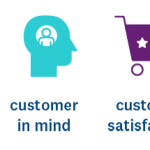
- Among employees with a great deal of customer empathy, 76% find their jobs meaningful. Among those with low customer empathy, only 49% find their jobs meaningful.
- Among employees who say that their work has a large impact on customers, 76% find their jobs meaningful. Among those who feel their work has little impact on customers 49% find their jobs meaningful.
- Among employees who say they think about customers at least once a week, 72% find their jobs meaningful. Among those who think about customers less often, only 58% find their jobs meaningful.
- Among employees who say customer satisfaction is a key priority in their organization, 73% find their jobs meaningful. Among those who say customer satisfaction is not a key priority, only 55% find their jobs meaningful.
New York Times columnist David Brooks talks about how to find meaning at work in his book, The Road to Character. He argues that self-confidence and happiness are tied to giving your work a sense of purpose. For himself, Brooks tries to connect the mundane parts of writing his column with the broader ideals of journalism. For other employees, connecting their day-to-day tasks with the concept of creating something with broad and lasting impact, like improving customer experience, gives a higher purpose to their job.
Harvard professor James L. Heskett reports that company culture “can account for 20-30% of the differential in corporate performance when compared with ‘culturally unremarkable’ competitors.” Making work meaningful for employees also has a meaningful impact on your bottom line.
Revenue obviously shouldn’t be your main motivator for fostering a positive culture, but when you’re lobbying for budget and resources to support new programs, it’s important to to be able to clearly illustrate their value. A job where employees can make an impact—and see the results firsthand—is very valuable to them, which in turn makes them better workers. If you can create that type of environment, it’s a big win for your people and your company.
Major finding #2: Customer centric cultures are associated with less attrition
An even more tangible metric? Attrition. The loss of good employees is cripplingly expensive for business. According to Employee Benefit News research, companies lose 33% of a worker’s annual salary each time they leave. Yikes. If you multiply that amount by the number of employees who leave their company because of a perceived lack of customer centricity, you’re looking at a significant financial impact.
According to our research, there are three factors of customer centricity that tie to less attrition. Here’s what may help employees to internally commit to two more years of working at their company:
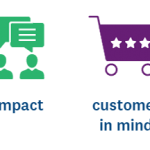
- Among people who perceive their company as having high customer empathy, 82% think that they will be working there in two years; among those who think their company has low empathy it’s 66%.
- Among people who consider their work customer-facing, 81% think that they will be working there in two years; among those who don’t feel their work directly affects customers, it’s 73%.
- Among people who say customer satisfaction is a key priority for their company, 83% think that they will be working there in two years; among those who don’t see customers as a high priority it’s 56%.

Real life story
We’ve seen this play out in the real world as well—a SurveyMonkey customer called PitchBook, which delivers data, research, and technology to the capital markets, has a core value that states “the “customer is king.”
With that in mind, the company reorganized its teams to better support their customers’ needs. Instead of having every customer success employee offer general support, each member of the team took on areas of special focus and technical expertise.
As hoped for, their customers were over the moon about the new structure. Product Marketing Manager JoAnne Baldwin said, "We’re hearing more and more often now that one of the reasons people love and stay loyal to PitchBook is because of our customer success team's invaluable reliability, depth of knowledge about our product and industry, and openness to receiving feedback and pass along to proper channels."
A less expected consequence? Satisfied employees. The new structure plays to PitchBook employees’ individual strengths and gives them a more focused relationship with each customer. Usually, when companies restructure it comes with a wave of attrition, but PitchBook’s teams have remained stable and both employees and clients are excited by the new structure. It looks like getting meaning from your job goes hand in hand with staying in it.
According to a SurveyMonkey research report, the threat of imminent attrition, in general, is high: 51% of employees state that they would take another job if it was offered, and 48% of people don’t see a clear path for themselves at their current company. That’s pretty dire for HR people who want to build a stable, reliable workforce. On the other hand, companies that make an effort to keep employees engaged through customer centricity initiatives and other learning and development programs are far more likely to have engaged employees and better retention.
This isn’t just about damage control: the potential advantages of having employees who are engaged in work that they consider meaningful are equally powerful—companies with engaged employees have 20% higher sales and 21% more profitability, according to Gallup. Whichever way you track it, customer centricity leads to metrics-backed HR success.
03 The customer centricity checklist
We used a variety of different questions to evaluate the relationship between employees and their customers, ranging from highly tangible things (like interacting with customers directly) to perception-based factors (like the level of empathy companies seem to have for their customers).
Five of the factors we checked for were positively connected to meaningfulness and attrition, which means that they’re all things that you should care about. Based on the data, we can’t conclusively say that one causes the other, but we can say that they’re connected and we highly recommend prioritizing accordingly. Here’s the list:
1. Individual customer empathy: Customer empathy started to get attention in the early 2010’s, mostly as a means of delivering better customer service. The Harvard Business Review began to index the 100 most empathetic companies, and reported that the top 10 companies in the Global Empathy Index “increased in value more than twice as much as the bottom 10, and generated 50% more earnings.”
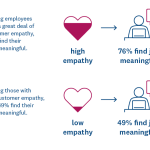
Employees that feel for the people they’re working to serve are far more likely to be fulfilled by their jobs. It makes sense—there may not be anything innately satisfying about queuing up emails or plugging numbers into a spreadsheet for some people. But if you understand that those emails contain important healthcare information for patients, or that the numbers represent small business owners investing in their future, the work gets more important and the employees are more drawn in.

Real life story
Zapier, a workflow automation company, has a program called “All Hands Support,” which requires every employee, from every part of the company, to spend at least 10% of their time each week week working with customers and answering their questions. Employees get the chance to associate real people and real needs with their sometimes distant-seeming customers.
“We see our employees learning more about our product, how our people interact with our product, and how to solve problems,” says Micah Bennett, Zapier’s support lead. “Our employees then take this newly-gained knowledge and empathy back to their day-to-day decisions.”
It’s probably not a coincidence that Zapier is growing quickly, attracting talent, and rallying people around their goal of helping employees become more productive at work.
2. Organizational customer empathy: But a “culture” of customer centricity can’t come from just one person, and we did see slight deviation in results between people who considered themselves empathetic and those who saw their employer that way. It needs to be clear that caring for customer pain points is something that both employees and their companies agree on—and can rally around.
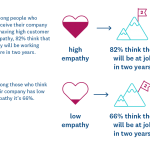

Real life story
Emma Snyder, a Customer Empathy Specialist at the restaurant technology company Toast is tasked with building a higher EQ into the company culture so that employees can put themselves in their customers’ place. In Toast’s case, customers are restaurant workers.
One of the first things that Snyder did in her new role was send an internal survey that doubled as an empathy building exercise. She asked employees whether they’d ever worked in a restaurant and, if so, when and what it was like. She asked them what they missed the most about the job, and why they left. The goal was to get employees, as a group, to reconnect with the challenges and rewards of their customers’ daily lives.
Not every company has the luxury of catering to customers that every employee can inherently relate to, but more and more companies are creating programs and roles that support this type of company-wide initiative—at the time of writing this report, searching LinkedIn for people with “empathy” in their title or summary delivers more than 200,000 results.
3. A clear path from work to customer: Sales and support people aren’t likely to forget about customers any time soon, but what about marketing teams, HR, or product? It’s easy to get bogged down in the day-to-day responsibilities of a busy job, and hard to self-motivate to take a step back and spare a thought for a far away, hypothetical customer. But it’s still incredibly important when it comes to keeping employees happy.
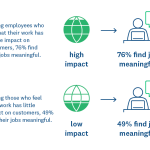
Tania Goldszmidt, VP of Customer Success and Digital Transformation for GE, was recently interviewed by customer centricity thought leader Allison Pickens, and said, “Customer Success is not just a function, it’s a cultural mindset that must be enabled across every department and cohesively measured and operationalized.”
Whether they’re a salesperson, an engineer, or an accountant, every person at your company needs to be able to draw a line between the work they do and the result for customers. “Clear a path from work to customer,” says Intuit CEO Brad Smith in an interview with Forbes. In the same interview, he explains how he (presciently) drew a connection between customer connection and employee happiness. “The best reward for employees is seeing the profound impact of their work on the lives of our more than 50 million customers.”
4. Consistently keep customers top-of-mind: Just like the human body, customer centricity needs consistent nourishment. We found that people who think about customers on at least a weekly basis are the ones who get the most out of it.
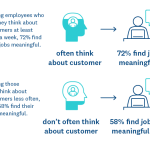

Real life story
At SurveyMonkey, we have Slack channels that automatically post comments from our customer feedback surveys and are followed most closely by the people designing and building our products. As our product manager Luxi Wang puts it, this channel is “an easy and engaging way to spur a steady habit of listening to customers."
The consistent influx of insights and feedback has been a good thing for Luxi’s team. The steady diet of customer feedback starts internal conversations, leads employees to follow up with customers who said something especially interesting, and gives people exciting new ideas about how to make the product better.
5. Customer satisfaction is a company priority: Are your corporate goals about solving customer problems, or meeting revenue numbers? Does the “winning” part of business overshadow the “keeping”? No company would say that customer satisfaction doesn’t matter, but saying that it does matter—and saying it often—isn’t necessarily as obvious. It might also be a matter of exposure: your customer service teams might see how far the company goes to improve customer satisfaction, but what about accounting or engineering?
Where empathy focuses on understanding customer pain points and understanding their experiences, customer satisfaction focuses on making sure customers are happy—specifically, happy with your product—and doing whatever it takes (within reason) to keep them that way.
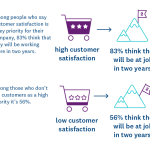
Customer experience expert Micah Solomon describes a culture of customer satisfaction as one where “service to customers is a way of life, a default position, something that is relentlessly pursued and refined.” He names 8 critical elements that companies need to have to achieve this type of culture, which include non-intuitive things, like celebrating customer experience “legends”, and coming up with secret internal languages that make employees feel like part of a team.
The challenge lies in adding meaning to these insights and turning them into realistic, achievable actions. How do you know whether your employees feel empathy for their customers? Whether they know how much your company does? Are there teams that are left in the dark? Before you can start to think about whether you need to change your company culture, you need to understand where you already are.
04 Measuring customer centricity with surveys
The only way to know how your employees feel about your customer culture is to ask. We created a Culture of Customer Centricity survey that can help you instantly affirm the areas where your company is thriving and where you may need to sew a few more seeds. This is especially important when you’re looking at different parts of your organization (departments, office locations, etc.). If there are areas where attrition is especially high, a missing sense of meaning might be part of the story.
Our survey was born two years ago when we got serious about building customer centricity into each employee’s day-to-day. While “Listen to Customers” has been one of SurveyMonkey’s core values for a long time, we wanted to really understand how connected individual SurveyMonkey employees felt to customers, how customer centric each team was, and how customers fit into our culture as a company.
We tracked how people’s feeling of connectedness and perception of SurveyMonkey’s customer centricity changed over time, and were able to identify which programs were helping and what else we could do to drive home the customer connection. Then, in the spirit of putting customers first, we decided to add the survey to our product so our users could treat it as a template to measure customer centricity at their own organizations.
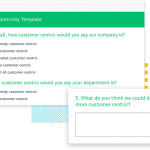
This template is just a starting point: what works for Salesforce or Clorox might not work for a 30-person company. The Customer Centricity survey helps you get a baseline of where your different teams and offices are, so you can take action that makes sense.
Our customer centricity survey template helps you:
- Evaluate how customer centric your employees think your organization is
- Evaluate how customer centric different departments or offices feel
- Understand how connected to customers individual employees feel
- Identify which programs and efforts are helping and what you can do to drive a more customer centric culture
Here are some ideas to help you make the most of this survey:
- ID the demographics that are most important to you so you can pinpoint how different parts of your organization are doing. Consider segmenting your survey by asking about team, office, seniority level, or where your business struggles most with retention.
- Consider adding an optional question (and let them know that it is optional!) and ask for their name so you can follow up to get more detailed information or enlist their help on taking action.
- When you’re ready to send your survey, you have a couple of different options: Email is probably the easiest, but you can also create web links if your org tends to rely more heavily on chat (like Slack or Google Hangouts) or internal message boards.
- Enlist leadership’s help to promote your survey and get people to respond. To get the response rates that you need, it can be helpful to send senior leaders an update about how many people from their team have responded and ask them send a reminder.
- Ideally, run the same survey twice a year so you can track how the feeling of connection to customers, and the perception of customer centricity, changes over time. This also lets you continue to evaluate what is working (or not!) and nimbly change course.
- Can’t send a survey to your entire organization? Pilot the first time around with a group or two that you think are the most important to check in on.
How customer centric is your organization?
You can deploy the Culture of Customer Centricity template instantly within your account.
Assess your culture of customer centricity
When you have your responses, you can start to diagnose your company culture. You can use the Analyze feature of the SurveyMonkey platform to filter your responses by answers to different questions. For example, you can choose to only see results from people who work in marketing, to see what the culture is like over there. Or, you can filter by the people who have the most negative impressions of your customers, to see if there are any common threads.
Finally, you can use our Compare feature to see whether there are differences in customer connection between different groups. Understanding cultural differences between different office locations or teams can help you think about what you might do to change them.
You can also make this a recurring survey, so that you can benchmark against your results as time goes on. We recommend sending it every six months. Did bringing in customer speakers make your employees feel more connected? Did an aggressive new sales goal destabilize your focus on customer happiness? Over time, you’ll be able to track how these factors changed—and even compare them to your retention metrics.
When you know more about how your organization relates to its customers, you’ll be able to identify opportunities to increase your employee engagement with customer programs. If your survey results show that your employees feel deeply connected with customers already—great! It means you have less to work on. If there are areas where the connection isn’t as clear, it just means that you have a chance to meaningfully increase engagement—often with the help of resources that are already available.
Bringing customers in as guest speakers, circulating customer stories and social media “love notes” internally, and building mandatory customer interactions into your business plans are just a few of the myriad of ways that you can start to develop a more nourishing customer-based culture.
05 Important considerations
Aim for the bigger picture, not just a snapshot
Not all customer engagements are created equal. To really empathize with customers (and get emotionally invested in their satisfaction), it’s helpful to know the broader narrative. Are they coming away from a bad experience with a competitor? What are their priorities? Have they asked for support before? Transparency can be the difference between “another task on my list” and “an opportunity to help someone achieve their goals.”

Real life story
Recently, Box used SurveyMonkey to eliminate the silos in the feedback that they were getting from customers at each stage of their experience. New customers would take a survey when they started…then again when they wanted to weigh in on features…then again when they interacted with customer service—but the information from each of those surveys wasn’t connected. In our case study on the topic, Chief Customer Officer, Jon Herstein says:
“As we started thinking more seriously about customer centricity and really understanding the voice of the customer, we needed a single tool that would enable us to understand sentiment across a number of different interactions we have with customers.”
If you’re having trouble with frustrated salespeople turning over, or marketing employees complaining that they don’t have enough information to work with, there might be dots that you can connect from existing resources that will make that “voice of the customer” more well-rounded for them. That sows the seeds for better empathy, and gives people a clearer sense of why their work is important—because it helps this real person solve this real problem.
As Jon puts it, “Today, we have a view of what the customer is doing, how things are going, and how they sit relative to their peers. That’s incredibly powerful.”
Customer centricity is a part of the solution—not everything
According to Jillesa Gebhardt, the SurveyMonkey survey scientist who worked on this report: “An absence of these factors has a larger impact than greater presence of the factors, indicating that a customer focus is table stakes to employees.” In other (non-survey scientist-y) words, you’re more likely to be hurt by missing out on customer centricity than to get ahead by adding it in. It’s not only an advantage to be customer-focused as an employer—it’s a necessity.
There’s a difference between asking employees to love your customers and asking them work themselves sick in the name of customer service. Customer centricity needs to come hand-in-hand with other programs that promote employee health and engagement, like good benefits, a reasonable workload, and an inclusive culture.
In an interview recently, Richard Branson said, “My philosophy has always been, if you can put staff first, your customer second and shareholders third (effectively, in the end), the shareholders do well, the customers do better, and you, yourself are happy.”
The reality is that companies don’t need to choose between supporting their employees and supporting their customers: they need to do both, together. Our research clearly shows that customer experience and employee experience are two sides of the same coin, and that HR and customer-facing teams who work together are far more likely to succeed than ones that don’t.
Report by Brooke Landon, Leader Voice of the Customer
Research by Jillesa Gebhardt, Research Scientist
Start measuring your culture of customer centricity—and everything else
SurveyMonkey Engage helps you keep a finger on the pulse of your organization, and keeps your employees feeling empowered and respected.
Methodology
Methodology: This poll was conducted online on July 9, 2018 among a total sample of 1,054 adults age 18 and over living in the United States, employed full or part-time. Respondents for these surveys were selected from an online panel where respondents take surveys in exchange for compensation. The modeled error estimate for the full sample is plus or minus 5 percentage points. Data have been weighted for age, race, sex, education, and geography using the Census Bureau’s American Community Survey to reflect the demographic composition of the United States age 18 and over.

